Hall 4 – smaller publishers (part 3)
Spiel '11 report section 7
Through a foyer-type area (useful for a cup of coffee or sandwich) at the end of hall 4 is hall 5, which will loop my tour back to the top of hall 10. However, the first thing I saw coming into hall 5 from this end was the busy stand shared by several French publishers. These include Le Joueur, whose excellent card game, Sandwich (ah: a good French word that!), I commented on in issue 118 of To Win Just Once (and gave it a definite 8/10).
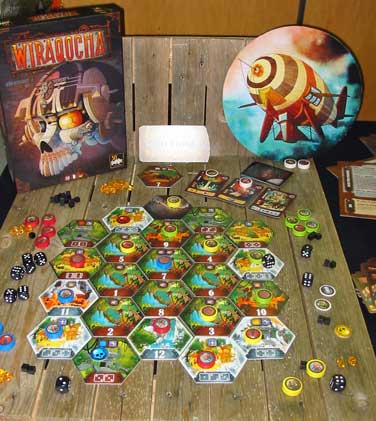 At the end of the stand was another new publisher with the wonderful name of Sit Down! that hails from Belgium. Their game was the unpronounceable Wiraqocha, a game of exploring and mining across the brightly coloured jungle tiles that make up the playing area. Players mine 'Somnium' (which is one way to win the game), conquer tiles, fight their
opponents, develop technologies and hunt for the pieces of a specific artefacts (a second way). They deploy
Explorers, Zeppelins and Drilling machines, all illustrated with a definite steampunk atmosphere. It was clear from the brief explanation that there's a lot going on in the game. Not least making best use of the dice you roll at the start of your turn. Players have to decide how best to pursue one of the game-winning goals and use the tactical options provided by the game and the other players to follow their strategy. It sounds interesting and I hope to give it a go soon.
At the end of the stand was another new publisher with the wonderful name of Sit Down! that hails from Belgium. Their game was the unpronounceable Wiraqocha, a game of exploring and mining across the brightly coloured jungle tiles that make up the playing area. Players mine 'Somnium' (which is one way to win the game), conquer tiles, fight their
opponents, develop technologies and hunt for the pieces of a specific artefacts (a second way). They deploy
Explorers, Zeppelins and Drilling machines, all illustrated with a definite steampunk atmosphere. It was clear from the brief explanation that there's a lot going on in the game. Not least making best use of the dice you roll at the start of your turn. Players have to decide how best to pursue one of the game-winning goals and use the tactical options provided by the game and the other players to follow their strategy. It sounds interesting and I hope to give it a go soon.
Just next door was another French publisher, Asyncron Games. Pride of place was given to their new revision of Fief. The game pits the players against each other as the lords of feudal manors, building up their fiefdom and competing with each other militarily, economically and politically. The new version looks splendid and was certainly providing good entertainment for those I saw playing it at Spiel. Asyncron has thoroughly overhauled the rules and provided scenarios for shorter games as well as the full-length campaign (which includes dynastic marriages, diplomacy between players and a lot more). Fief is definitely worth trying and I look forward to giving it a go.
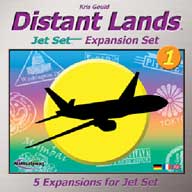 Across the aisle were my old friends at Wattsalpoag, the US publisher that produces Kris Gould's games. I was particularly interested in Distant Lands, the expansion set for my favourite of Kris's games, Jet Set. The first thing this does is add more cards to the game. These have two effects. First, they provide more variety to the game. Secondly, because there are more cards in the decks, the game will last longer. As one of the keys to the game is spotting when the end is likely to be triggered, this does make a change to the game.
Across the aisle were my old friends at Wattsalpoag, the US publisher that produces Kris Gould's games. I was particularly interested in Distant Lands, the expansion set for my favourite of Kris's games, Jet Set. The first thing this does is add more cards to the game. These have two effects. First, they provide more variety to the game. Secondly, because there are more cards in the decks, the game will last longer. As one of the keys to the game is spotting when the end is likely to be triggered, this does make a change to the game.
On top of this, there are four different expansions in the box and you can add them to the base game on their own or in any combination. I immediately like the 'Distant Lands', which are long-haul flights, providing players with another option in their tactics. 'Hubs' provide bonuses for establishing a hub to your airline, depending on just how much it gets used. Again, this adds another twist that could change the balance of the game. 'Business' cards give players bonus actions that should make developing their airline easier. And 'Investment' cards provide some additional scoring during the game. Interesting stuff that I'll be trying out as soon as I get the chance.
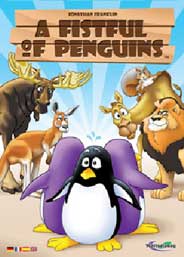 Wattsalpoag had a new game as well: Fistful of Penguins is their first that's not designed by Kris, Jonathan Franklin is the man behind this one. It's a quick, simple, Yahtzee-like dice-rolling game. However, here the dice show animal symbols, not numbers. Each different animal scores in a different way. Lions are worth lots of points, but you don't score any
other animals-that's predators for you. Squirrels steal from other players, while Moose only score for those Moose
that have a Squirrel with
them! And the penguins give you tokens (good-looking translucent plastic pieces) that allow you to roll extra dice or re-roll.
Wattsalpoag had a new game as well: Fistful of Penguins is their first that's not designed by Kris, Jonathan Franklin is the man behind this one. It's a quick, simple, Yahtzee-like dice-rolling game. However, here the dice show animal symbols, not numbers. Each different animal scores in a different way. Lions are worth lots of points, but you don't score any
other animals-that's predators for you. Squirrels steal from other players, while Moose only score for those Moose
that have a Squirrel with
them! And the penguins give you tokens (good-looking translucent plastic pieces) that allow you to roll extra dice or re-roll.
The game is great fun, plays quickly and provides a real temptation to push your luck and roll the dice just one more time... I was not surprised that the game had sold out well before the end of Spiel. Luckily, Wattsalpoag have plenty more in their warehouse and it should be readily available. I give Fistful of Penguins 8/10 from my first meeting.
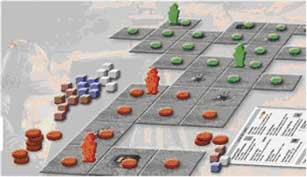 A little further along the hall was Italian publisher Giochix with two new games this year. The Forgotten Planet, designed by Giochix main man Michele Quondam, is about exploring the eponymous planet, laying tiles to show the terrain as the players travel round. Each player has a team of robots that it uses
to prospect
the planet, looking for valuable minerals. The robots must place metal paths as they go, providing both stable routes and energy
supply.
A little further along the hall was Italian publisher Giochix with two new games this year. The Forgotten Planet, designed by Giochix main man Michele Quondam, is about exploring the eponymous planet, laying tiles to show the terrain as the players travel round. Each player has a team of robots that it uses
to prospect
the planet, looking for valuable minerals. The robots must place metal paths as they go, providing both stable routes and energy
supply.
As well as exploring, the robots build mines and can construct walls to keep other players away. Robots can move or destroy walls, too, potentially giving access to other players' resources. All of these activities cost energy, which is the way players' actions are limited. Robots on mines produce resources, which can be used in several ways, including turning them into victory points. At the end of the game, players get points for their holdings, which is the main way of winning.
The Forgotten Planet sounds intriguing, but it is very abstract: square grey tiles played onto the table with wooden discs and cubes-and robots, of course. I shall definitely give it a try, but I would have liked something that looked a bit more like exploring a planet.
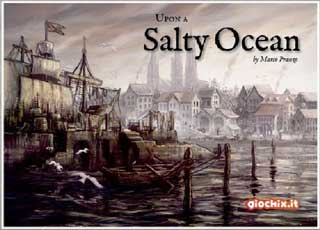 Upon a Salty Ocean, from designer Marco Pranza, looks altogether more atmospheric. The board shows the city of Rouen, France's main port at the beginning of the 16th century, laid out on the banks of an estuary. The city's wealth was based on fishing in the Atlantic, using local salt to preserve the catch. Players start with a ship, a salt mine and some cash and must
build themselves a commercial empire.
Upon a Salty Ocean, from designer Marco Pranza, looks altogether more atmospheric. The board shows the city of Rouen, France's main port at the beginning of the 16th century, laid out on the banks of an estuary. The city's wealth was based on fishing in the Atlantic, using local salt to preserve the catch. Players start with a ship, a salt mine and some cash and must
build themselves a commercial empire.
This immediately sounds like my kind of game. While fishing is clearly where players start from, they can invest their income in the different buildings around the city. Initially, their investments will be to build up their trade: more ships, more salt mines and warehouses to store stock. Other buildings provide an income and then there are the grand, prestigious projects, such as the great cathedral and its stained glass windows and the Hôtel de Ville. The winner is the richest player at the end of the game-I was particularly taken with the rule that players are limited in the cash they can hold until they have a bank! Another intriguing game that I look forward to playing.
 Along the back wall were a number of smaller stands. The first one I visited was Ascora Games, a US publisher whose first appearance at Spiel was with Kaigan last year. This time they had Nefarious, a new card game from Donald X Vaccarino (best-known as the man who gave us Dominion). I was intrigued by the odd-shaped meeples that
come with the game. They look almost hump-backed I said, just as I spotted the sub-title on the posters:
"The game of mad scientists". All fell into place-every
mad scientist needs his Igor and here they get a whole team of them.
Along the back wall were a number of smaller stands. The first one I visited was Ascora Games, a US publisher whose first appearance at Spiel was with Kaigan last year. This time they had Nefarious, a new card game from Donald X Vaccarino (best-known as the man who gave us Dominion). I was intrigued by the odd-shaped meeples that
come with the game. They look almost hump-backed I said, just as I spotted the sub-title on the posters:
"The game of mad scientists". All fell into place-every
mad scientist needs his Igor and here they get a whole team of them.
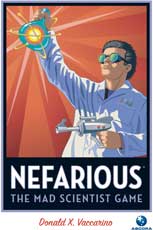 Each player has a 'lair' card where they can assign their team of eager assistants to their jobs. They also have a set of four cards for the four actions available each turn. Players all choose their actions by selecting cards, revealing them simultaneously and implementing them in order. Essentially, the actions allow players to research new inventions (drawing from a deck of cards), play an invention
(which
costs money) or generate themselves some money-even mad scientists need to work!The first
player to reach a target value of inventions triggers the end of the game and the winner is the player with the highest value when they've all finished their turn. This is huge fun and plays simply and very quickly (more quickly than you might expect). To provide variety, a further deck of 'Twist' cards provides additional constraints to the game. Two are drawn at the start of the game and remain in place throughout. A simple, but very effective way of ensuring the game is different each time you play.
Each player has a 'lair' card where they can assign their team of eager assistants to their jobs. They also have a set of four cards for the four actions available each turn. Players all choose their actions by selecting cards, revealing them simultaneously and implementing them in order. Essentially, the actions allow players to research new inventions (drawing from a deck of cards), play an invention
(which
costs money) or generate themselves some money-even mad scientists need to work!The first
player to reach a target value of inventions triggers the end of the game and the winner is the player with the highest value when they've all finished their turn. This is huge fun and plays simply and very quickly (more quickly than you might expect). To provide variety, a further deck of 'Twist' cards provides additional constraints to the game. Two are drawn at the start of the game and remain in place throughout. A simple, but very effective way of ensuring the game is different each time you play.
I had huge fun playing this at the show, added to by the atmospheric pulp fiction-style illustrations. The Twist cards give the game re-play value (otherwise I can see it getting rather same-y after the fourth time) and I think Ascora have a hit. Nefarious gets 9/10 on my highly subjective scale.
Next door was Bézier Games and supremo Ted Alspach. As well as his usual Age of Steam expansions, Ted was demonstrating the prototype of Mutant Meeples, which he described as Ricochet Robots with knobs on. As with the old game, the aim is to move one of the pawns to the target point by bouncing it off the walls and other pawns. Here, however, the pawns are mutant meeples and each has a super power!Players not only have to work out the fastest path for getting to the target, they have to take into account each meeple's power. I always found Ricochet Robots melted my brain, so this is one game that really doesn't appeal to me. Ted has launched this on Kickstarter to raise the funds for publication early in 2012 (and is halfway there at the end of October).
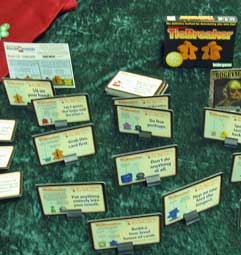 Ted had one game to show off in its finished form: Tiebreaker. This follows his ingenious Start Player in providing a simple way of dealing with a perennial problem when playing games. In this case, the problem is: how do you resolve a tie at the end of a game? Simple, draw a card from the Tiebreaker deck and the first to carry out
the forfeit-style
activity
wins the tie. To get a better idea of what this is about, take a look at the wonderful video Ted has posted on BoardGameGeek (follow the link).
Ted had one game to show off in its finished form: Tiebreaker. This follows his ingenious Start Player in providing a simple way of dealing with a perennial problem when playing games. In this case, the problem is: how do you resolve a tie at the end of a game? Simple, draw a card from the Tiebreaker deck and the first to carry out
the forfeit-style
activity
wins the tie. To get a better idea of what this is about, take a look at the wonderful video Ted has posted on BoardGameGeek (follow the link).
Sharing the stand with Bézier was Omnigames from Denmark with their card game, Rising Kings. This is a relatively simple game: players draw a card and play cards. Each card has a special effect and builds up the players' own part of the kingdom in front of them. The game ends when the deck runs out and players may get some bonus points as well as the points for their buildings and characters. The player with the most points becomes King. Not a deep game, but one that is enhanced by the charming illustrations on the cards.
At the far end of the hall, just before heading back into hall 10, I finally found Treefrog Games, the new name for Martin Wallace's imprint. Their new position is excellent as they are the first thing people will see as they enter hall 5 from the main halls. Treefrog had made the most of it, too, using game artwork to great effect by merging elements from the various games on huge wall panels. It was arresting.
The games being played were, of course, Ankh-Morpork and A Few Acres of Snow. I covered both of these in To Win Just Once 116, so I won't go into detail here. Ankh-Morpork is great fun, but don't expect a deep strategy game: it's chaos all the way. (It was also to be seen in other languages on several other stands-Iello (French), Kosmos (German), Mayfair (American) and so on). A Few Acres of Snow is a terrific card-driven wargame on the French/British conflict over what is now Canada. I give 'em both 9/10 after playing each several times.
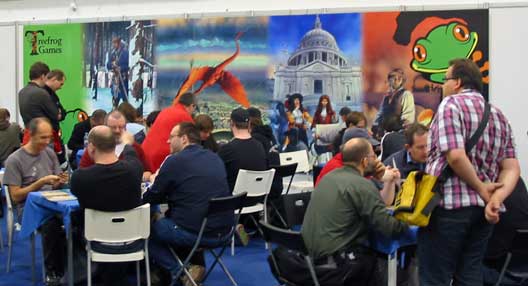 The Treefrog stand with its highly effective backdrop
The Treefrog stand with its highly effective backdrop
Martin had one new game on show. Old Men of the Forest is a relatively simple card game. Each participant plays a card, the two who played the highest cards each claim one card from those played. They use the right set of these to get an Orangutan card from the middle of the table, which will score them points at the end of the game. However, any surplus cards are tucked under the Orangutan and count as penalties at the end. It's neat, quick to play and all profits are going to the UK Orangutan Foundation. It gets 7/10 from me.
 US publisher Stratamax Games was sharing with Treefrog again and they also had a card game to show off. Let's Take a Hike is designed by Stratamax regular Aaron Lauster and is all about a gentle stroll in the country. Or not. Players draw and play cards to fill their backpack and pockets. Sooner or later the group will go on a hike, turning over
cards from the deck to encounter hazards-including the odd bear. If a player has a matching card in their
backpack, they keep going. Otherwise they must discard
cards with the same number of bootprints on them. If they decide to drop out of the hike, they take a card which will provide some points at the end. So Let's Take a Hike is a push-your-luck game where players have to decide what risks to take and how long to keep going before scoring some points. It's good fun, but, for British hikers, is distressingly without any Kendal Mint Cake!
US publisher Stratamax Games was sharing with Treefrog again and they also had a card game to show off. Let's Take a Hike is designed by Stratamax regular Aaron Lauster and is all about a gentle stroll in the country. Or not. Players draw and play cards to fill their backpack and pockets. Sooner or later the group will go on a hike, turning over
cards from the deck to encounter hazards-including the odd bear. If a player has a matching card in their
backpack, they keep going. Otherwise they must discard
cards with the same number of bootprints on them. If they decide to drop out of the hike, they take a card which will provide some points at the end. So Let's Take a Hike is a push-your-luck game where players have to decide what risks to take and how long to keep going before scoring some points. It's good fun, but, for British hikers, is distressingly without any Kendal Mint Cake!
Next section: Wrapping up
Previous section: Hall 8, 7 and 6 — Comic Action, newbies, role-play and wargames
